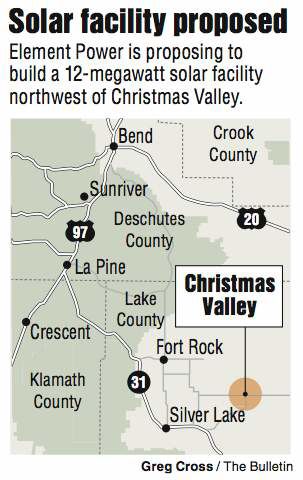Lake County solar project advances
Published 5:00 am Thursday, October 28, 2010

- Lake County solar project advances
Sunny Christmas Valley could become home to Oregon’s largest solar power facility, as a Portland company has received a conditional use permit from Lake County to build the 12-megawatt project 11 miles northwest of the community.
The lack of rain, number of sunny days and other factors make the area a prime spot for a solar farm, said Nicole Hughes, senior project manager with Element Power.
Trending
The company is proposing to build a project on about 100 acres of private land, generating enough electricity to power about 6,000 homes.
“We’re hoping to get a power purchase agreement signed this year, then begin construction in the spring,” Hughes said.
The $47 million project would be located close to a major Bonneville Power Administration power line, she said — so the developers will not have to go far to connect the solar farm to the power grid.
The company received a permit from the Lake County Planning Commission last week, after conducting studies that found the project would not harm endangered species.
However, the company still needs to get an exception to the statewide land use rule that prohibits energy projects on more than 12 acres of high-value farmland, or 20 acres of low-value farmland, said Ken Gerschler, Lake County planning director. The company also has to work with the state Historic Preservation Office to ensure that it will not disturb archaeological sites.
The area has drawn interest from other solar companies, Gerschler said.
Trending
For example, Obsidian Finance Group, also based in Portland, has proposed installing four solar farms, ranging from 20 acres to 80 acres, in the area, Gerschler said. The Land Use Board of Appeals is reviewing those proposals, he said, after the county determined Obsidian could develop on the farmland because a water moratorium in the area prohibits future agriculture.
Another developer has started building a small solar facility just outside of Christmas Valley, he said, but is trying to line up additional funding.
Gerschler thinks more solar companies will be interested if the land use issues are ironed out.
“I think at this point, we have a lot of other interested parties, but they’re watching the Obsidian proposals and they’re also watching the Element proposal to see if they’re successful,” he said. “If Element (Power) gets through all the challenges and they start building, then we can anticipate that we’ll see some more.”
Companies are attracted to the area not only because of the clear skies and cool temperatures, but because there is available land to buy or lease, he said. Plus, there are nearby transmission lines that would make it relatively easy for the power facilities to connect to and get the power into the grid.
Transmission lines
The proximity to the transmission lines is one of the reasons the Element site is a good one for a solar farm, said Brent Fenty, executive director of the Oregon Natural Desert Association.
“We think development should be prioritized in areas where transmission already exists, and disturbances have already occurred,” he said.
At the Element site, people have already built roads and fences, and it’s not a key habitat area for sage grouse or pygmy rabbits. It is in an area where mule deer spend the winter, Fenty said, and he has talked with the developer about how to improve conditions for the deer.
“In general, from an environmental perspective, it looks like this is a good site for solar development,” Fenty said.
But the solar projects also have drawn opposition.
Gary Perkins, a Christmas Valley rancher, is a member of the recently formed Concerned Citizens of North Lake County. While he favors solar power and sees a need for renewable energy in the United States, he said he and others are concerned about the location of the proposed solar farms. Also, Lake County doesn’t have a sufficient plan for where the solar facilities can or can’t go, he said.
“If we’re going to spread this all over the desert, where’s your plan?” Perkins said.
Obsidian is proposing to install solar panels 35 feet from a neighbor’s property line, and the Element project is near another resident’s farm, he said. Some residents don’t want the solar farms so close, he said, noting that at 8,000 square miles, there is plenty of room for energy projects and the 7,500 residents.
“When you have 8,000 square miles, it seems like you could put it a mile away, two miles away from farms,” he said.








